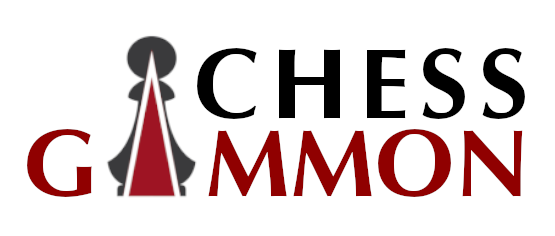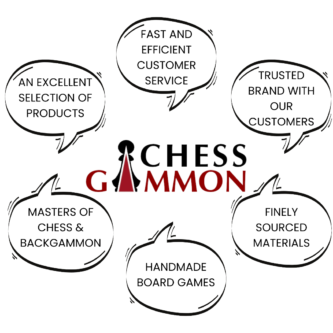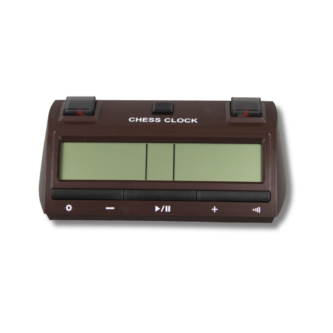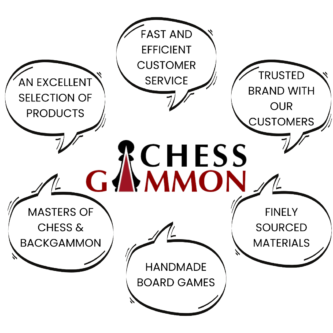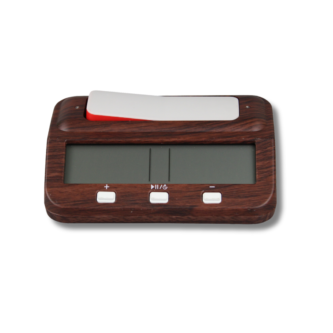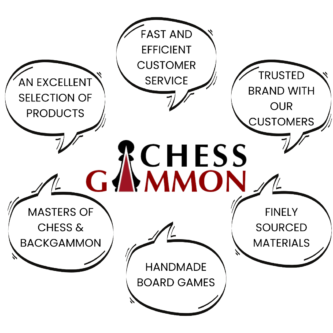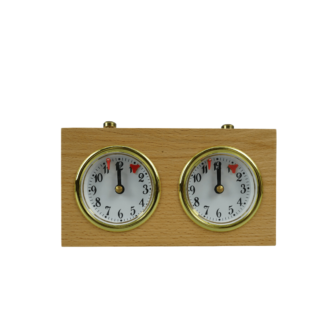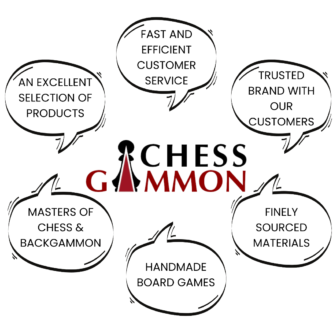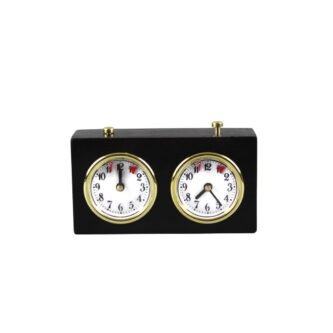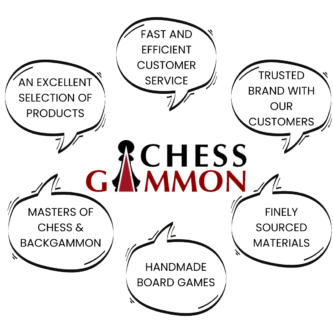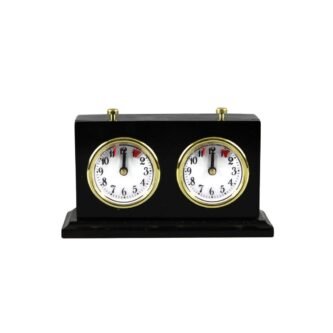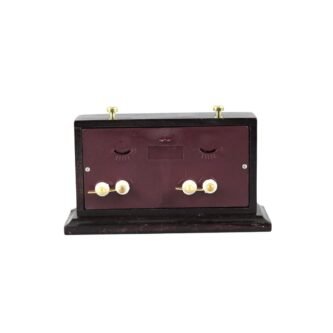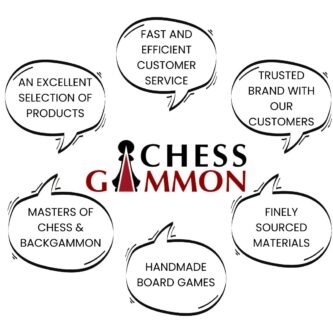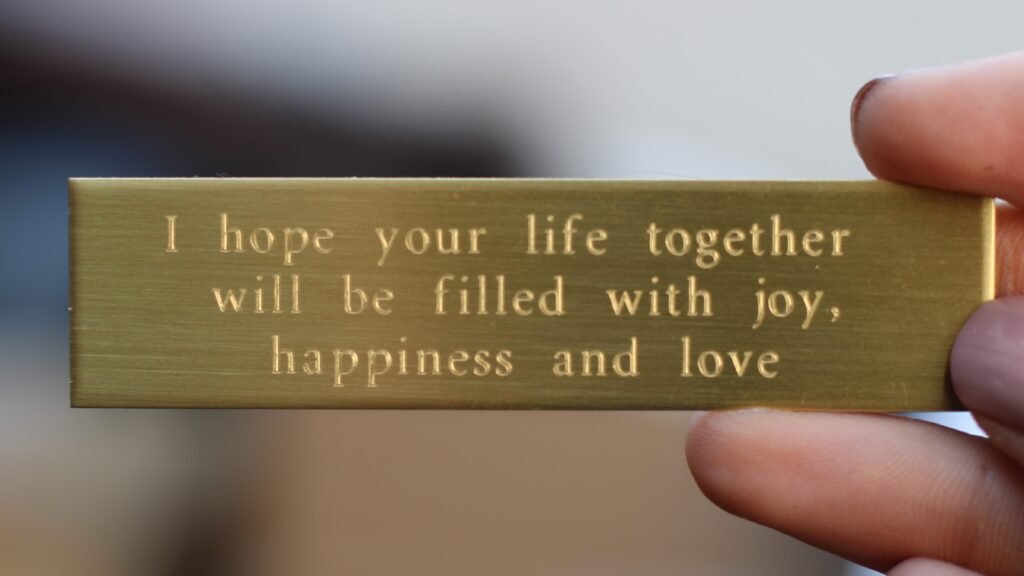Chess Clock
- You cannot add "Chess Clock Digital Black DGT" to the cart because the product is out of stock.
Wooden Chess Clock
In the realm of strategic board games, chess stands tall as a timeless classic that challenges the minds of players worldwide. As chess enthusiasts immerse themselves in the intricacies of the game, one crucial element that often takes centre stage during competitive play is the chess clock. In this article, we will delve into the world of “Wooden Chess Clocks,” exploring their significance and unique attributes that make them a prized possession for players and collectors alike.
Brief Explanation of the Article’s Purpose:
The primary purpose of this article is to shed light on wooden chess clocks, examining their historical roots, functional aspects, and the reasons they hold a special place in the hearts of chess aficionados. Additionally, we will explore the advantages of choosing wooden analog clocks over their digital counterparts, highlighting their aesthetic appeal and the joy they bring to players during intense gameplay.
Definition of Wooden Chess Clocks:
Wooden chess clocks, also known as wooden chess timers or wooden analog chess clocks, are timekeeping devices designed specifically for chess matches. Unlike standard clocks, these specialized timekeeping instruments come equipped with dual timers, one for each player, allowing them to monitor their allotted time to make moves in the game.
Typically crafted from high-quality wood, these clocks exemplify fine craftsmanship and add an aura of sophistication to any chess setup. Their mechanical design, coupled with the tactile experience of winding and pressing buttons, has garnered them a loyal following among chess enthusiasts seeking a more traditional and elegant timekeeping option.
Importance and Role of Chess Clocks in Competitive Chess:
In the world of competitive chess, time management plays a pivotal role in strategizing and executing moves effectively. Chess clocks were introduced to regulate the pace of play, ensuring that each player gets an equal amount of time to contemplate and execute their moves. This addition revolutionized the game by adding an element of urgency, thereby simulating the pressures of real-life decision-making.
In a tournament setting, chess clocks serve as impartial arbiters, maintaining fairness and order. The infamous “time pressure” that arises during critical moments of a match challenges players to think quickly while maintaining accuracy—a skill highly regarded in the competitive chess community.
Stay tuned as we explore the rich history, benefits, and tips for choosing the perfect wooden chess clock to elevate your chess-playing experience to a new level of precision and elegance. Whether you are an ardent chess player, a collector of exquisite chess equipment, or simply curious about the art of timekeeping in the game of intellect, this article is your gateway to understanding the timeless charm of wooden chess clocks.
History of Chess Clocks
Origins of Chess Clocks in Tournament Play:
The concept of chess clocks was born out of the need to regulate competitive play and prevent games from becoming excessively drawn-out affairs. Prior to the introduction of timekeeping devices, chess matches had no limitations on how long a player could take for their moves. This led to matches that could last for hours, days, or even weeks, particularly in high-stakes tournaments.
The first recorded instance of chess clocks being used in tournament play dates back to the 19th century. It is believed that the Austrian chess master Wilhelm Steinitz proposed the idea of a timekeeping device during a chess tournament held in London in 1883. Although this initial attempt was relatively rudimentary, it laid the foundation for more sophisticated timekeeping mechanisms that would soon revolutionize competitive chess.
Evolution of Chess Timing Devices:
Following Steinitz’s proposal, chess enthusiasts and clockmakers collaborated to develop increasingly advanced timekeeping devices for chess matches. The first mechanical chess clocks used a dual pendulum system, where each player’s time was measured by the motion of separate pendulums. These clocks provided a considerable improvement in tournament efficiency, prompting their adoption in international chess competitions.
Over time, mechanical chess clocks evolved to use a lever system and eventually embraced the innovative use of springs, which allowed for more precise time measurement. These advancements revolutionized the competitive chess landscape, as players were now compelled to strategize within a limited timeframe, adding a thrilling dimension of time pressure to the game.
The Transition to Digital Chess Clocks and the Resurgence of Wooden Analog Clocks:
The latter half of the 20th century witnessed a significant shift in chess clock technology with the advent of digital chess clocks. Digital clocks offered greater accuracy, programmable time controls, and additional features such as time delay and increment settings. These digital marvels became the new standard in tournament play and have remained popular in various chess circles.
While digital chess clocks continue to dominate the market, the nostalgia and aesthetic appeal of wooden analog clocks have seen a resurgence in recent years. Chess enthusiasts and collectors alike have developed a newfound appreciation for the craftsmanship and traditional charm that wooden chess clocks exude. These wooden timekeepers offer a unique tactile experience, with players winding the clocks and pressing buttons to manage their time – an experience that cannot be replicated by digital clocks.
Furthermore, wooden chess clocks have become sought-after collector’s items, with various artisanal designs and craftsmanship that add a touch of elegance to any chess set. Players are drawn to the natural beauty of wooden clocks, which seamlessly blend into classic and vintage chess setups, elevating the ambiance of chess matches.
In conclusion, the history of chess clocks showcases a fascinating journey from the early days of experimental timekeeping to the modern era of digital precision. While digital clocks have become a staple in tournament play, the allure of wooden analog clocks endures, reminding us of the timeless elegance and artistry that continues to captivate chess enthusiasts worldwide.
Benefits of Wooden Chess Clocks:
Aesthetic Appeal and Craftsmanship:
Wooden chess clocks stand out for their unparalleled aesthetic appeal and exquisite craftsmanship. Crafted from high-quality wood, these timekeepers boast a natural beauty that complements any chess set or gaming environment. The wood’s warm tones and intricate grain patterns add an element of sophistication to the chess-playing experience.
Chess enthusiasts appreciate the attention to detail that goes into the making of wooden clocks. Artisans take great care in selecting premium woods and employing traditional woodworking techniques, resulting in timepieces that are not only functional but also works of art. The elegance and timeless charm of wooden chess clocks make them a prized possession for players and collectors alike.
Eco-friendly and Sustainable Choice:
In an era where environmental consciousness is paramount, wooden chess clocks offer a sustainable alternative to plastic and electronic counterparts. Wood is a renewable resource, and responsible sourcing practices ensure that these clocks have a minimal impact on the environment.
By choosing wooden chess clocks, players can contribute to a more eco-friendly chess culture, aligning their passion for the game with a commitment to preserving the planet’s resources for future generations.
Unique Features and Customization Options:
Wooden chess clocks often boast a variety of unique features and customization options that cater to individual preferences. From different wood species and finishes to intricate engravings and inlays, players have the freedom to personalize their timekeepers according to their tastes and styles.
Additionally, some wooden clocks come with integrated scorekeeping functionality, further enhancing the overall gaming experience. Customizable features make these clocks not only timekeeping devices but also cherished mementos, reflecting the personalities and passions of their owners.
Tactile Experience and Nostalgic Value:
One of the most captivating aspects of wooden chess clocks is the tactile experience they offer during gameplay. The process of winding the clock and gently pressing the buttons to stop and start timers adds a sense of tangible involvement to each move, enhancing the emotional connection players have with the game.
For many, wooden chess clocks evoke a sense of nostalgia, harking back to a time when traditional analog clocks were the norm in chess tournaments. The tactile and mechanical nature of these clocks creates a unique ambiance, evoking memories of classic chess matches and the revered players of the past.
In conclusion, wooden chess clocks embody a host of benefits that elevate the chess-playing experience beyond mere timekeeping. Their timeless beauty, eco-friendliness, customization options, and the nostalgia they evoke all contribute to making wooden chess clocks a cherished and valuable addition to any chess player’s collection. Whether used in casual matches or intense tournament play, these elegant timekeepers continue to hold a special place in the hearts of chess enthusiasts worldwide.
How Wooden Chess Clocks Work?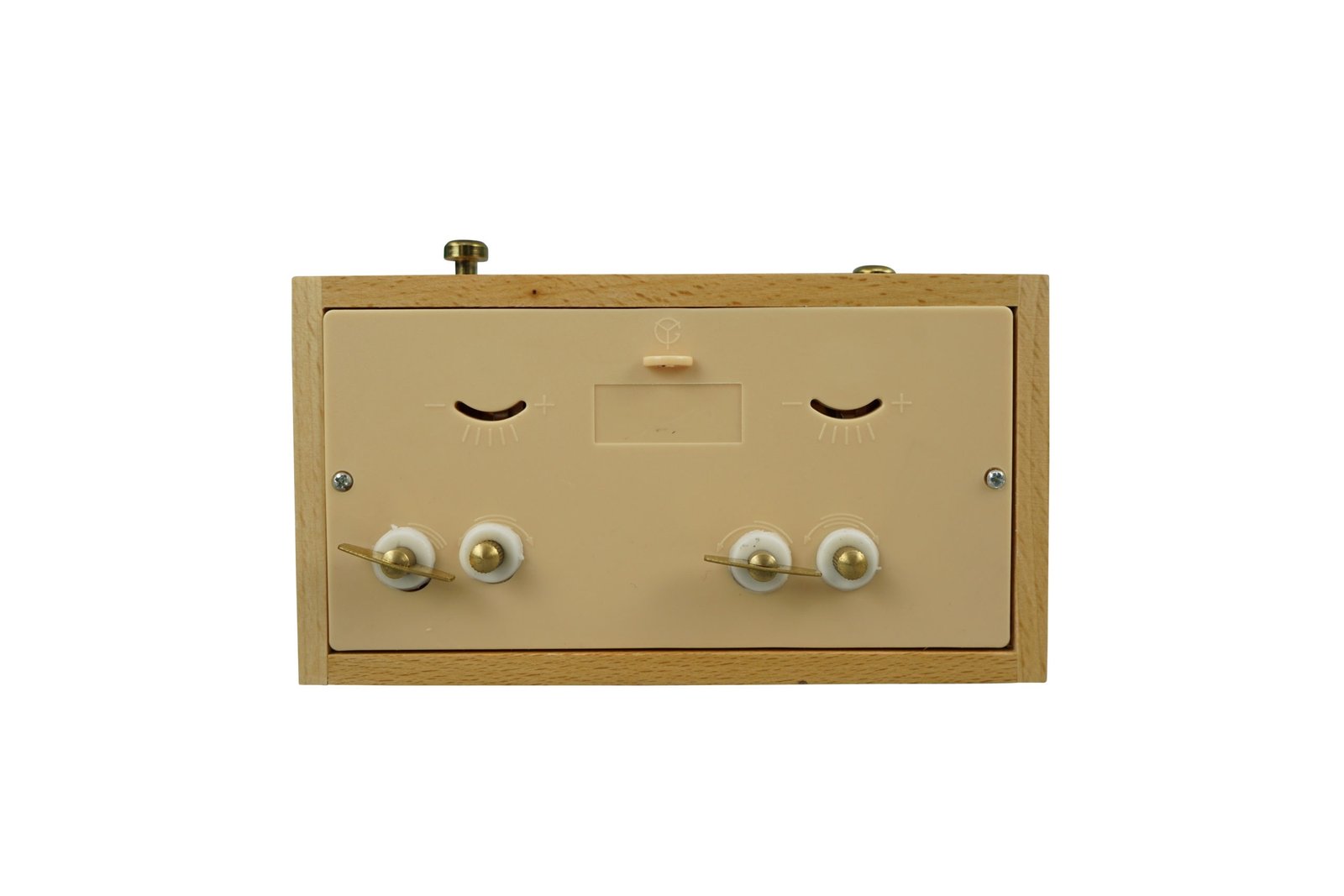
Explanation of the Mechanics behind Wooden Analog Clocks:
Wooden chess clocks, also known as analog clocks, operate using simple yet ingenious mechanical mechanisms. Inside the wooden casing, the clock consists of two main components: the clockwork and the flag mechanism.
- Clockwork: The clockwork is responsible for tracking and displaying the time for each player. It consists of a spring-loaded mechanism that drives the clock’s hands, just like a traditional wall clock. When a player presses the button on their side of the clock, it releases the tension in their clockwork, causing their timer to start counting down.
- Flag Mechanism: The flag mechanism is a unique feature of wooden chess clocks that visually indicates when a player’s time is up. Each player has a small flag attached to their clock, which rises when their time runs out. The raised flag serves as a clear and immediate signal to both players that the game has concluded due to time expiration.
Operation and Setting Options:
Operating a wooden chess clock is straightforward. Before the game begins, players wind up their respective clocks by turning a knob or lever, storing potential energy in the clockwork. Once the game commences, the players take turns to make their moves. After making a move, a player must press their clock’s button to stop their timer and start their opponent’s timer simultaneously.
The setting options on wooden chess clocks allow players to customize the time controls for the game. Typical setting options include:
- Time Per Player: This setting determines the total amount of time each player has to complete the entire game. For example, the clock may be set to give each player 30 minutes for the entire game.
- Time Delay: Time delay, also known as Fischer delay, grants a bonus time to each player after they make a move. For instance, if the time delay is set to 5 seconds, a player will have an additional 5 seconds added to their clock after each move.
- Time Increment: Time increment, similar to time delay, adds extra time to a player’s clock after each move. However, the added time becomes a permanent part of the player’s remaining time, rather than delaying the opponent’s clock.
Comparing Analog and Digital Chess Clocks:
Analog and digital chess clocks serve the same purpose: to regulate the time for each player in a game. However, they differ in their mechanisms, features, and overall user experience.
- Mechanism: Analog chess clocks use mechanical components with clockwork and flag mechanisms, providing a tactile and classic experience. In contrast, digital chess clocks use electronic circuitry and display screens to track time with precision.
- Precision: Digital clocks offer greater accuracy and precision compared to analog clocks. Digital clocks can handle more complex time control settings, including time increments and multiple time periods, while analog clocks have limitations in this regard.
- User Interface: Digital clocks often have user-friendly interfaces with buttons and screens that allow for easy setting and adjustment of time controls. Analog clocks, on the other hand, may require more manual adjustments and familiarity with the clockwork.
- Aesthetics: Wooden analog clocks are favoured for their aesthetic appeal and vintage charm, blending seamlessly with classic chess sets. Digital clocks, however, may lack the traditional appeal but provide a modern and sleek appearance.
In conclusion, wooden chess clocks function through mechanical ingenuity, offering a unique and nostalgic experience for players. They provide straightforward operation and customizable time controls, allowing players to immerse themselves in the strategic aspects of the game. While digital clocks excel in precision and versatility, wooden analog clocks continue to captivate players with their classic beauty and tangible timekeeping experience.
Choosing the Right Wooden Chess Clock:
Factors to Consider When Buying a Wooden Chess Clock:
When selecting a wooden chess clock, several essential factors come into play to ensure that you make the right choice for your chess-playing needs:
- Quality of Craftsmanship: Look for clocks crafted from high-quality wood and assembled with precision. Quality craftsmanship ensures durability and adds to the clock’s overall aesthetic appeal.
- Timer Accuracy: Ensure that the clock’s timekeeping mechanism is reliable and accurate, with consistent timing for both players.
- Size and Portability: Consider the size and weight of the clock, especially if you plan to use it for travel or tournaments. A compact and portable wooden chess clock is convenient for on-the-go gaming.
- Ease of Use: Look for a clock with user-friendly buttons and clear indicators for ease of operation during intense gameplay.
- Setting Options: Check for a variety of setting options, such as time per player, time delay, and time increments, to suit your preferred time controls and game formats.
- Battery or Manual Operation: Decide whether you prefer a wooden clock that operates on batteries or a purely mechanical clock that requires winding.
Different Styles and Designs Available:
Wooden chess clocks come in various styles and designs, each offering a unique aesthetic and visual appeal. Some popular styles include:
- Classic Wooden Design: These clocks feature a timeless, traditional look with elegant wood finishes that blend seamlessly with classic chess sets.
- Modern and Contemporary: For those seeking a more modern touch, some clocks feature sleek and minimalist designs with smooth, polished wood surfaces.
- Ornate and Artisanal: Artisanal wooden chess clocks often showcase intricate engravings, inlays, or carvings, making them exquisite collector’s items.
- Vintage Replicas: Some clocks replicate the designs of historic analog chess clocks, capturing the nostalgia of the past.
Budget Considerations and Price Ranges:
The price of wooden chess clocks can vary based on factors such as brand, craftsmanship, and additional features. Entry-level models may be more budget-friendly, while high-end artisanal clocks with intricate details may come at a premium.
It is essential to set a budget before shopping for a wooden chess clock. Determine the price range that fits your budget and prioritize the features that matter most to you. While some players may prefer to invest in an exquisite artisanal clock, others may find a reliable and reasonably priced clock that meets their needs just as well.
Ultimately, choosing the right wooden chess clock is a personal decision that hinges on your playing style, preferences, and budget. By considering the factors mentioned above and exploring the various styles available, you can find the perfect wooden chess clock that adds both functionality and aesthetic charm to your chess games.
Using a Wooden Chess Clock in Chess Tournaments:
Proper Handling and Care:
Proper handling and care of a wooden chess clock are essential to ensure its longevity and optimal performance throughout chess tournaments. Here are some tips to keep in mind:
- Gentle Operation: Handle the clock with care, avoiding rough or forceful actions when pressing the buttons or winding the clock.
- Avoid Impact: Prevent the clock from experiencing heavy impacts or drops, as this can damage the delicate clockwork inside.
- Clean Regularly: Dust and debris can accumulate on the clock’s surface over time. Clean the clock regularly with a soft, dry cloth to maintain its polished appearance.
- Storage: When not in use, store the wooden chess clock in a secure and dust-free location to protect it from potential damage.
Standard Time Controls in Tournaments:
Chess tournaments typically use standard time controls to regulate the pace of play and ensure fairness among players. The most common time controls include:
- Standard Time: In standard time controls, each player is allotted a specific amount of time for the entire game. For instance, in a 90-minute game, each player may have 45 minutes to complete all their moves.
- Time Delay: Time delay, also known as Fischer delay, grants players a bonus amount of time after each move. For example, with a 5-second time delay, a player will have an additional 5 seconds added to their remaining time after making a move.
- Time Increment: Time increment, similar to time delay, adds extra time to a player’s clock after each move. However, this added time becomes a permanent part of their remaining time, rather than delaying their opponent’s clock.
The specific time controls used in a tournament may vary, so it’s essential to familiarize yourself with the tournament’s rules and regulations beforehand.
Tips for Players to Manage Time Effectively:
Time management is a critical skill in chess tournaments, and using a wooden chess clock effectively can make all the difference in a player’s performance. Here are some tips to manage time efficiently:
- Plan Ahead: Use your opponent’s time wisely by thinking about your moves during their turn. Have a rough plan in mind before it’s your turn to move.
- Avoid Time Trouble: Be mindful of your clock’s timer and avoid reaching time trouble, where you have limited time left to complete many moves.
- Prioritize Important Moves: Allocate more time to critical and complex moves that require careful consideration.
- Stay Calm and Composed: Nervousness and anxiety can lead to rushed moves. Stay calm and composed to make confident decisions.
- Practice Time Management: Regularly practice with a chess clock to get comfortable with managing time effectively during tournament games.
By mastering time management and handling your wooden chess clock with care, you can enhance your tournament performance and fully enjoy the competitive spirit of chess. A well-maintained wooden chess clock will not only accompany you through numerous tournaments but also serve as a cherished memory of your chess journey.
Maintenance and Care of Wooden Chess Clocks:
Cleaning and Preserving the Wooden Clock’s Finish:
Proper cleaning and preservation of the wooden chess clock’s finish will not only keep it looking beautiful but also ensure its longevity. Here’s how to maintain the clock’s lustre:
- Use a Soft Cloth: Gently dust the clock’s surface with a soft, lint-free cloth regularly to remove any accumulated dirt or debris.
- Avoid Harsh Cleaners: Refrain from using harsh chemicals or abrasive cleaners that may damage the wood’s finish. Instead, opt for a mild wood cleaner or a damp cloth for tougher stains.
- Polish Occasionally: To maintain the clock’s shine, use a high-quality wood polish specifically designed for the type of wood used in your clock. Follow the manufacturer’s instructions for application.
- Keep Away from Moisture: Prevent the clock from coming into contact with water or excessive moisture, as it may warp the wood and compromise the clock’s structural integrity.
Storage and Protection from Damage:
Proper storage and protection are crucial for safeguarding the wooden chess clock when not in use or during transport to tournaments. Consider the following measures:
- Secure Enclosure: When not in use, store the clock in a secure and dust-free enclosure. A soft cloth or a padded bag can help protect the clock from scratches and impacts.
- Avoid Sunlight: Prolonged exposure to direct sunlight can fade the wood’s colour over time. Store the clock away from sunlight or cover it when not in use.
- Transport with Care: When taking the clock to chess tournaments or events, use a padded chess clock bag or case to protect it from potential damage during transit.
Common Troubleshooting and Maintenance Tips:
While wooden chess clocks are generally durable, occasional maintenance and troubleshooting may be required to ensure smooth operation:
- Lubricate Moving Parts: If the clock’s hands or buttons start to feel stiff, apply a small amount of clock oil or silicone-based lubricant to the moving parts. Avoid using too much oil, as it may attract dust.
- Check for Loose Parts: Periodically inspect the clock for any loose screws or components. Tighten them carefully, but not excessively, to avoid damage.
- Address Mechanical Issues: If you encounter any mechanical issues with the clock, such as irregular timekeeping or malfunctioning buttons, consider seeking assistance from a professional clock repair expert.
- Professional Servicing: For comprehensive maintenance and servicing, especially if your clock has complex features like time delay or increment, consider taking it to a clock repair specialist who is familiar with wooden chess clocks.
By following these maintenance and care guidelines, you can preserve the beauty and functionality of your wooden chess clock for many years to come. A well-maintained clock not only enhances your chess playing experience but also becomes a cherished heirloom that you can pass down to future generations of chess enthusiasts.
Conclusion:
Recap of the Benefits of Wooden Chess Clocks:
Throughout this exploration of wooden chess clocks, we have unravelled a multitude of benefits that make them a remarkable addition to any chess player’s collection:
- Aesthetic Appeal and Craftsmanship: Wooden chess clocks boast a timeless beauty and exquisite craftsmanship, elevating the ambiance of any chess setup.
- Eco-friendly and Sustainable Choice: Choosing a wooden clock aligns your passion for chess with a commitment to a more sustainable and eco-friendly gaming experience.
- Unique Features and Customization Options: With various styles and designs available, wooden clocks offer customization options that reflect players’ personalities and preferences.
- Tactile Experience and Nostalgic Value: The mechanical nature of wooden chess clocks brings a sense of nostalgia and adds a tangible connection to the game of intellect.
Final Thoughts on the Significance of Chess Clocks in the Game:
Chess clocks have played an integral role in revolutionizing the world of competitive chess. By introducing a sense of urgency and time management to the game, chess clocks have challenged players to think strategically while under pressure. The steady “tick-tock” of the clock marks each passing second, heightening the intensity and excitement of every move. Chess clocks have become synonymous with the essence of competitive play, and their influence on the game is immeasurable.
Encouraging Readers to Consider a Wooden Chess Clock for Their Games:
As you immerse yourself in the captivating world of chess, a wooden chess clock presents an opportunity to elevate your playing experience to new heights. Beyond its practical functionality, a wooden clock offers an artisanal masterpiece that stands as a testament to the time-honoured traditions of chess. Its tactile nature and timeless charm evoke a profound sense of connection to the game and its heritage.
Whether you are an avid chess player, a devoted collector, or someone who simply cherishes the artistry of fine chess equipment, a wooden chess clock is a valuable investment that transcends the boundaries of time. Its presence on your chessboard not only serves as a beacon of precision but also as a reminder of the enduring allure of this ancient game of intellect.
So, dear readers, as you embark on your chess journey, consider embracing the elegance and sophistication of a wooden chess clock. Allow its meticulously crafted hands to guide your moves, and let the tick of the clock propel you towards a realm of strategic brilliance. With every chess match, let the resonance of the wooden clock’s ticking remind you of the timeless beauty and ever-evolving artistry that is chess.
